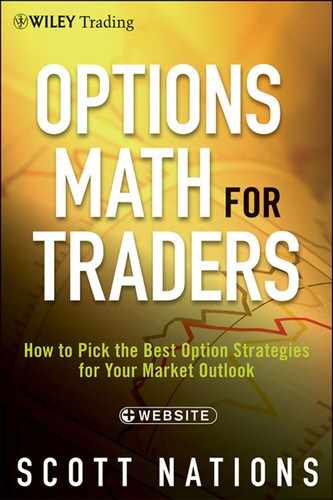Book Description
A practical guide to the math behind options and how that knowledge can improve your trading performance
No book on options can guarantee success, but if a trader understands and utilizes option math effectively, good things are going to happen. The idea behind Options Math for Traders + Website is to help retail option traders understand some of the basic tenants and enduring relationships of options, and option math, that professional and institutional traders rely on every day. This book skillfully highlights those strategies that are inherently superior from an option math point of view and explains what drives that superiority while also examining why some strategies are inherently inferior.
The material is explained without complex equations or technical jargon. The goal is to give you a solid conceptual foundation of options behavior so you can make more informed decisions when choosing an option strategy for your market outlook. Topics covered include the volatility premium, because over time, options will cost more than they are ultimately worth; skew, wherein far out of the money put options may seem cheap from an absolute term, but are very expensive in relative terms; and the acceleration in option price erosion. The book also has a companion Website, which includes links to those sites that can scan for the best strategies discussed in the book.
Explains, in a non-technical manner, the mathematical properties of options so that traders can better select the right options strategy for their market outlook
Companion Website contains timely tools that allow you to continue to learn in a hands-on fashion long after closing the book
Written by top options expert Scott Nations
Most independent traders have an imperfect understanding of the math behind options pricing. With Options Math for Traders + Website as your guide, you'll gain valuable lessons in this area and discover how this information can improve your trading performance.
Table of Contents
- Cover
- Series
- Title Page
- Copyright
- Dedication
- Preface
- Acknowledgments
- Part One: The Basics
- Part Two: The Phenomena
- Chapter 5: The Volatility Risk Premium
- Chapter 6: Implied Volatility and Skew
- Chapter 7: Time Value and Decay
- Chapter 8: The Bid/Ask Spread
- WHAT DO WE MEAN BY “THE MARKET”?
- MARKET MAKERS
- BID/ASK SPREAD, THE WHAT
- DELTA'S IMPACT ON BID/ASK SPREADS
- WIDER BID/ASK SPREADS
- THE BID/ASK SPREAD WHEN THERE'S MORE COMPETITION
- EQUITY OPTIONS
- THE BID/ASK FOR OPTION SPREADS
- THE BID/ASK OF MULTI-LEGGED SPREADS
- WHAT'S THE REAL FAIR VALUE OF AN OPTION BASED ON THE BID/ASK?
- Chapter 9: Volatility Slope
- Part Three: The Trades
- Chapter 10: Covered Calls
- COVERED CALLS ARE BEST FOR STOCKS YOU ALREADY OWN AND WANT TO KEEP
- THE PHENOMENA AND COVERED CALLS
- BREAKEVEN POINTS
- BREAKEVEN POINTS AND RATES OF RETURN
- USING COVERED CALLS FOR DOWNSIDE PROTECTION
- IF OUR STOCK RALLIES
- SELECTING THE COVERED CALL
- COVERED CALLS AND DAILY PRICE EROSION
- COVERED CALLS AND THE VOLATILITY RISK PREMIUM
- PLACING YOUR COVERED CALL ORDER
- FOLLOW-UP ACTION
- GETTING ASSIGNED
- ROLLING
- Chapter 11: Selling Puts
- Chapter 12: Calendar Spreads
- MAXIMUM PROFIT AND LOSS
- THE PHENOMENA
- LONG CALENDAR SPREADS AND IMPLIED VOLATILITY
- CALENDAR SPREAD PAYOFF AT FRONT-MONTH EXPIRATION
- NEUTRAL, BULLISH, AND BEARISH CALENDAR SPREADS
- CALENDAR SPREAD PROFITABILITY WITHOUT MOVEMENT
- CALENDAR SPREAD SENSITIVITIES
- FOLLOW-UP
- BULLISH BECOMES BEARISH…
- CATALYSTS
- Chapter 13: Risk Reversal
- Chapter 14: Vertical Spreads
- BREAKEVENS
- SKEW AND VERTICAL SPREADS
- VERTICAL SPREAD RISK AND REWARD
- LONG PUT SPREADS AND SHORT CALLS SPREADS ARE ALIKE
- LONG PUT SPREADS AND SHORT CALL SPREADS ARE DIFFERENT
- THE WIDTH OF THE SPREAD VERSUS THE COST
- THE GREEKS
- IMPLIED VOLATILITY AND THE COST OF VERTICAL SPREADS
- VERTICAL SPREADS—HOW AGGRESSIVE?
- CALL SPREADS, SKEW, AND THE PROBLEM OF THE “TROUGH”
- FOLLOW-UP ACTION
- Chapter 10: Covered Calls
- Appendix
- Index
